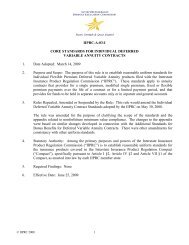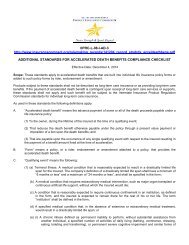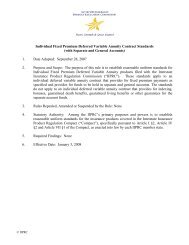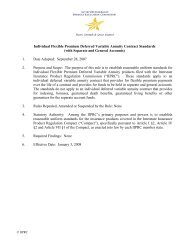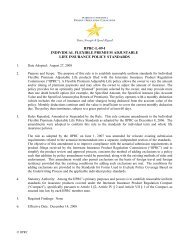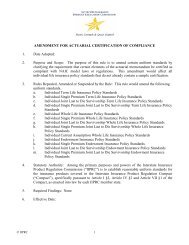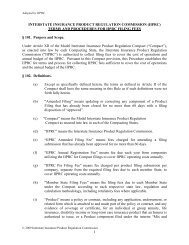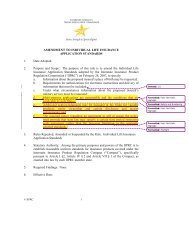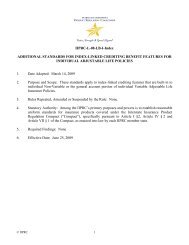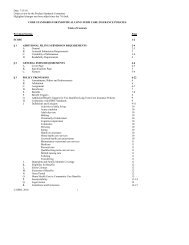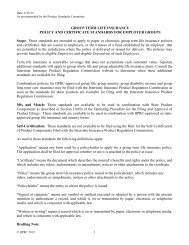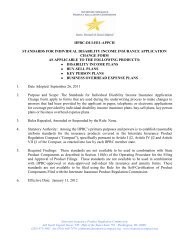Individual Life Insurance Application Standards - Interstate ...
Individual Life Insurance Application Standards - Interstate ...
Individual Life Insurance Application Standards - Interstate ...
Create successful ePaper yourself
Turn your PDF publications into a flip-book with our unique Google optimized e-Paper software.
IIPRC-L-I-APP<br />
INDIVIDUAL LIFE INSURANCE APPLICATION STANDARDS<br />
1. Date Adopted: October 29, 2008<br />
2. Purpose and Scope: The purpose of the amendments is as described in Paragraph 3. The<br />
<strong>Individual</strong> <strong>Life</strong> <strong>Insurance</strong> <strong>Application</strong> <strong>Standards</strong> apply to paper, telephonic or electronic<br />
new business applications for coverage provided by individual life insurance policy<br />
forms. These standards do not apply to applications for Credit <strong>Life</strong> <strong>Insurance</strong>.<br />
3. Rules Repealed, Amended or Suspended by the Rule: This rule amends the <strong>Individual</strong><br />
<strong>Life</strong> <strong>Insurance</strong> <strong>Application</strong> <strong>Standards</strong> adopted by the <strong>Interstate</strong> <strong>Insurance</strong> Product<br />
Regulation Commission (“IIPRC”) on February 28, 2007.<br />
This rule was amended for the purpose of clarifying the <strong>Individual</strong> <strong>Life</strong> <strong>Insurance</strong><br />
<strong>Application</strong> <strong>Standards</strong> to specify:<br />
a. Information about the proposed insured’s place of birth may be requested;<br />
b. Requirements for authorizations for electronic instructions and delivery of<br />
information that must be included;<br />
c. Under what circumstances information about the proposed insured’s military<br />
service must be requested;<br />
d. Multi-purpose applications are permissible and the conditions that are applicable<br />
to such filings;<br />
e. Additional acknowledgments may be included in the filing for variable products,<br />
entity ownership and certain disclosure and receipt requirements; and<br />
f. The required notice regarding an agreement to sell or assign the policy must<br />
provide that state law may specify a certain time period restricting such<br />
agreement, rather than the two-year limitation in the originally adopted standards.<br />
4. Statutory Authority: Among the primary purposes and powers of the IIPRC is to<br />
establish reasonable uniform standards for insurance products covered under the<br />
<strong>Interstate</strong> <strong>Insurance</strong> Product Regulation Compact (“Compact”), specifically pursuant to<br />
Article I §2, Article IV § 2 and Article VII § 1 of the Compact, as enacted into law by<br />
each IIPRC member state.<br />
5. Required Findings: None<br />
6. Effective Date: February 12, 2009<br />
© IIPRC 1
Date: 10/28/08<br />
Adopted by the IIPRC<br />
INDIVIDUAL LIFE INSURANCE APPLICATION STANDARDS<br />
Scope: These standards are intended to apply to paper, telephonic or electronic<br />
applications for coverage provided by individual life insurance policy forms. These<br />
standards are intended to apply to new business applications as well as applications used<br />
to request changes to existing policies.<br />
The company may submit one multi-purpose application to accommodate new business<br />
and all policy changes (conversion, reinstatement, exercise of guaranteed insurability<br />
increase in the amount of insurance, plan changes, risk class improvements, planned<br />
premium changes, addition of benefit feature, changes to existing benefit features,<br />
substitute of insureds, etc.), submit separate applications for each purpose, or submit an<br />
application with any combination of purposes (new business and reinstatement only,<br />
reinstatement and conversion only, all policy changes only, etc.).<br />
Separate additional standards will apply to applications for Credit <strong>Life</strong> <strong>Insurance</strong> or for<br />
any combination of life, annuity, disability income and long term care insurance<br />
applications. Consult the IIPRC web site to determine when additional standards are<br />
available for filing.<br />
As used in these standards the following definitions apply:<br />
“<strong>Application</strong>” means any form used to apply for life insurance whether or not the form is<br />
attached to the policy at issue. The application form shall be filed for approval.<br />
“Signed or signature” means any symbol or method executed or adopted by a person with<br />
the present intention to authenticate a record, and which is on or transmitted by paper,<br />
electronic or telephonic media, and which is consistent with applicable law.<br />
“Written or writing” means a record which is on or transmitted by paper, electronic or<br />
telephonic media, and which is consistent with applicable law.<br />
§ 1 ADDITIONAL SUBMISSION REQUIREMENTS<br />
A. GENERAL<br />
The following additional filing submission requirements shall apply:<br />
(1) All forms filed for approval shall be included with the filing. Changes to a<br />
previously approved form shall be highlighted.<br />
(2) The application may be submitted in a proof format for preliminary review,<br />
provided that the company certifies that the text and format so filed accurately<br />
reflects what the final copy would look like, including contrasting color, font size,<br />
bold face, highlighting, or any other similar type of differentiation that may be<br />
used. If the application is determined to be acceptable, the company shall submit<br />
© IIPRC 2
Date: 10/28/08<br />
Adopted by the IIPRC<br />
a final copy for approval, along with a certification that the final copy represents<br />
an exact copy of the proof and that no changes had been made after the company<br />
was notified that the proofs were determined to be acceptable.<br />
(3) If the application is submitted for use by more than one company, the following<br />
requirements shall apply:<br />
(a)<br />
(b)<br />
The name of each company shall appear at the top of the first or cover<br />
page of the application, and a means of designating the appropriate<br />
company must be available, such as checkboxes in front of each<br />
company’s name. A “blank space write in” format will not be acceptable;<br />
Multiple companies may be represented in one filing, provided that:<br />
(i)<br />
(ii)<br />
(iii)<br />
All companies shown at the top of the first or cover page of the<br />
application are properly licensed in all states for which the filer is<br />
requesting approval;<br />
The filer is requesting approval for an identical filing (no<br />
exceptions for any company represented in the filing) in all states<br />
for which the filer is requesting approval; and<br />
Separate filing fees may apply and transaction fees for each<br />
combination of company and state shall apply; and<br />
(c)<br />
The application shall have the same form number for each company, and<br />
the form number shall be unique within each company.<br />
(4) If the application will be used for multiple purposes:<br />
(a) The intended purpose shall appear at the top of the first or cover page of<br />
the application, and a means of designating the intended use purpose shall<br />
be available, such as a checkbox in front of each usepurpose. A “blank<br />
space write in” format is not acceptable.<br />
(b)<br />
The applicant shall be provided instructions that specify which sections of<br />
the application must be completed for each purpose.<br />
(5) The filing shall include all the sections and questions that may be required to be<br />
completed by an applicant, including additional drop downs, scripts, questions,<br />
questionnaires or supplements that would be required if the applicant answers<br />
questions in a certain way, such as a “yes” response.<br />
(6) If a filing is being submitted on behalf of a company, a letter or other document<br />
authorizing the firm to file on behalf of the company shall be included with the<br />
filing.<br />
© IIPRC 3
Date: 10/28/08<br />
Adopted by the IIPRC<br />
(7) If the application contains variable items, the submission shall include the<br />
Statement of Variability. The submission shall also include a certification that any<br />
change or modification to a variable item shall be administered in accordance<br />
with the requirements in the Variability of Information section, including any<br />
requirements for prior approval of a change or modification.<br />
(8) A certification signed by a company officer that the application has a minimum<br />
Flesch score of 50, if applicable. If a life application or sections of a life<br />
application are subject to federal jurisdiction, and accordingly the Appendix A<br />
requirements will not apply, the certification shall include a statement to that<br />
effect.<br />
(9) A statement of the types of policy forms and plans with which the application will<br />
be used. For example, whole life, term life, endowment, Universal <strong>Life</strong>,<br />
Survivorship coverage, limited death benefit forms, pre-need funeral forms, or<br />
variable life forms.<br />
(10) A statement of how the application will be used, such as paper, electronic, and/or<br />
telephonic. For electronic and telephonic uses, the company shall:<br />
(a)<br />
(b)<br />
Describe the procedures that will be used to verify the authenticity of the<br />
transaction; and<br />
Include a John Doe sample that shows additional sections and questions<br />
that are required to be completed by an applicant, including additional<br />
drop downs, scripts, questions, questionnaires or supplements, if the<br />
applicant answers questions in a certain way, such as a “yes” response.<br />
Additionally, for telephonic uses the company shall describe the process by which<br />
the applicant is given the completed application for signature prior to or on the<br />
date the policy is issued.<br />
(11) A description of any innovative or unique features of the application.<br />
(12) If the replacement questions will be included in a separate form, a certification<br />
that this is the case.<br />
(13) For variable life plans, if the suitability questions and disclosure will be included<br />
in a separate form, a certification that this is the case.<br />
B. VARIABILITY OF INFORMATION<br />
(1) The company may identify items that will be considered variable in the<br />
application, but such variability shall be limited to:<br />
(a)<br />
The company, address and other contact information;<br />
© IIPRC 4
Date: 10/28/08<br />
Adopted by the IIPRC<br />
(b)<br />
In the case of applications for use by more than one company, the name of<br />
each company may be variable only to permit:<br />
(i)<br />
(ii)<br />
Deletion if the company ceases to do new business; and<br />
Addition of a company authorized to do business by the respective<br />
<strong>Interstate</strong> <strong>Insurance</strong> Product Regulation Commission member<br />
states;<br />
(c)<br />
Plan information, including plan marketing name or logo.<br />
The item shall be bracketed or otherwise marked to denote variability. The<br />
submission shall include a Statement of Variability that will discuss the<br />
conditions under which each variable item may change.<br />
(2) If the company identifies plan information that may be variable in the application,<br />
such information shall be consistent with the Statement of Variability that has<br />
been or is being filed for use with the respective policy form. For variable life<br />
insurance plans, items such as the Separate Accounts and Funds available under<br />
the plan may be identified as variable to the extent allowed by the policy form.<br />
C. READABILITY REQUIREMENTS<br />
(1) The application text shall achieve a minimum score of 50 on the Flesch reading<br />
ease test or an equivalent score on any other approved comparable reading test.<br />
See Appendix A for Flesch methodology. This requirement shall not apply to life<br />
applications or sections of life applications that are subject to federal jurisdiction.<br />
(2) The application text shall be presented in not less than ten point type, one point<br />
leaded.<br />
(3) The style, arrangement and overall appearance of the application shall give no<br />
undue prominence to any portion of the text or section of the application.<br />
§ 2 GENERAL FORM REQUIREMENTS<br />
A. COVER PAGE OR FIRST PAGE<br />
(1) The full corporate name of the company shall appear in prominent print on the<br />
cover page or first page of the application. “Prominent print” means, for example,<br />
all capital letters, contrasting color, underlined or otherwise differentiated from<br />
the other type on the form.<br />
(2) If an application will be used by more than one company, each company’s full<br />
corporate name shall appear in prominent print on the cover page of the<br />
© IIPRC 5
Date: 10/28/08<br />
Adopted by the IIPRC<br />
application, and a means of designating the appropriate company must be<br />
available, such as checkboxes in front of each company’s name.<br />
(3) If an application will be used for multiple purposes, the intended purpose shall<br />
appear at the top of the first or cover page of the application and a means of<br />
designating the appropriate use purpose must be available, such as a checkbox in<br />
front of each use purpose.<br />
(4) If the application will be used for policy changes, the application shall:<br />
(a)<br />
(b)<br />
Instruct the applicant to provide the policy number for the existing policy<br />
for which change is being requested; and<br />
Identify the insured to whom the changes apply.<br />
(5) A marketing name or logo may also be used on the cover page or first page of the<br />
application provided that the marketing name or logo does not mislead as to the<br />
identity of the company.<br />
(6) Each company’s complete mailing address shall appear on the cover page or first<br />
page of the application.<br />
(7) A form identification number shall appear at the bottom of the application in the<br />
lower left hand corner of the application. The form number shall be adequate to<br />
distinguish the form from all others used by the company. The form number shall<br />
include a prefix of ICCxx (where xx represents the appropriate year the form was<br />
submitted for filing) to indicate it has been approved by the <strong>Interstate</strong> <strong>Insurance</strong><br />
Product Regulation Commission.<br />
(8) A brief description that shall appear in prominent print on the cover page or the<br />
first page of the application indicating that the application is for individual life<br />
insurance.<br />
B. FAIRNESS<br />
(1) The application shall not contain inconsistent, ambiguous, unfair, inequitable or<br />
misleading clauses, provisions that are against public policy as determined by the<br />
<strong>Interstate</strong> <strong>Insurance</strong> Product Regulation Commission, nor shall it contain<br />
exceptions and conditions that unreasonably affect the risk purported to be<br />
assumed in the general coverage of the policy forms with which the application<br />
will be used.<br />
(2) The application questions shall be presented as single direct questions, not as<br />
declaratory statements.<br />
(3) Open ended questions are not permitted.<br />
© IIPRC 6
Date: 10/28/08<br />
Adopted by the IIPRC<br />
(4) The application questions shall not require the applicant to make a diagnosis of a<br />
medical condition of the proposed insured. Questions such as “Are you in good<br />
health,” “Do you have symptoms of,” “Do you have any known indication of,” or<br />
“Do you think you have” are not acceptable.<br />
§ 3 APPLICATION SECTIONS<br />
A. PROPOSED INSURED<br />
(1) The application shall request the information that the company determines it<br />
needs to identify the proposed insured and provide contact information, such as:<br />
name, address, telephone number, email address, age, date of birth, place of birth,<br />
gender, occupation, tax identification or social security number, marital status,<br />
current employment information, and driver license number and state and country<br />
of issue, or other official document used to verify identity. The section may<br />
accommodate joint, corporate or trustee applicants.<br />
B. OTHER PROPOSED INSURED<br />
(1) The application may allow the applicant to designate other proposed insureds and<br />
provide the information that the company determines it needs to identify the other<br />
proposed insureds and their related contact information. Such information may be<br />
the same as that required for the proposed insured.<br />
C. TYPE OF PLAN<br />
(1) The application shall allow the applicant to specify the type of life insurance plan<br />
selected for each proposed insured, such as: the policy plan of insurance (such as<br />
term, whole life, variable or non-variable, first to die, second to die, joint, etc.)<br />
additional benefits (such as accelerated death, accidental death, waiver of<br />
premium, guaranteed insurability, etc.), dividend options, automatic premium<br />
loan, maturity date, and investment options for variable life plans.<br />
(2) For variable life insurance plans, the application shall require the applicant to<br />
answer questions designed to elicit information which enables the agent to<br />
determine the suitability of the variable plan to the applicant, in compliance with<br />
the requirements published by the National Association of Security Dealers and<br />
disclose the risks involved. The disclosure shall be in prominent print and shall<br />
include acknowledgement by the applicant that the policy values that are based on<br />
the separate account assets are not guaranteed and will decrease or increase with<br />
investment experience. Alternatively, the company may include the suitability<br />
questions and disclosure in a separate form, and, if this is the case, the company<br />
shall certify to this.<br />
© IIPRC 7
Date: 10/28/08<br />
Adopted by the IIPRC<br />
D. PREMIUM AND BILLING<br />
(1) The application shall allow the applicant to specify the amount paid with the<br />
application, a payor if other than the owner, premium mode and billing<br />
information. If a payor is other than the owner, the application shall request the<br />
payor information needed by the company to administer the insurance plan, such<br />
as the payor’s name, telephone number, address, email address, tax identification<br />
or social security number, and relationship to the owner and the insured.<br />
(2) The application may request information concerning the source and/or method of<br />
funding the premium payments.<br />
E. OWNER<br />
(1) The application shall allow the applicant to designate the owner and provide the<br />
owner information that the company determines it needs to administer the<br />
insurance plan, such as the owner’s name, telephone number, address, email<br />
address, tax identification or social security number, and relationship to the<br />
insured. The section may accommodate joint, corporate, trustee, custodian, or<br />
UTMA/UGMA applicants.<br />
F. BENEFICIARY<br />
(1) The application shall allow the applicant to designate the beneficiary and shall<br />
require the beneficiary information that the company determines it needs to<br />
confirm insurable interest and administer the insurance plan, such as the<br />
beneficiary’s name, telephone number, address, email address, tax identification<br />
or social security number, and relationship to the insured.<br />
(2) The application may state that unless otherwise directed, the insurance proceeds<br />
shall be divided equally among all persons who are named as primary beneficiary<br />
and who survive the insured, but if none survive, equally among all persons who<br />
are named as contingent beneficiary and who survive the insured.<br />
G. AGREEMENT TO SELL OR ASSIGN POLICY FOR WHICH<br />
APPLICATION IS BEING MADE<br />
(1) The application may include a question regarding whether any party to the<br />
application, such as the applicant, proposed insured, owner, if other than the<br />
applicant, or any beneficiary, has entered or has made plans to enter into any<br />
agreement or contract to sell or assign the ownership of, or a beneficial interest in<br />
the applied for policy. The application may also include a question regarding<br />
whether any person has promised or agreed to give or has given to any party to<br />
the application, or that any party to the application has received or will receive<br />
from any person, any inducement, fee or compensation as an incentive to<br />
© IIPRC 8
Date: 10/28/08<br />
Adopted by the IIPRC<br />
purchase the policy. For a “yes” response, details shall be requested regarding<br />
any agreement or incentive.<br />
(2) The application may include a question regarding whether any party to the<br />
application, such as the applicant, proposed insured, owner, if other than the<br />
applicant, or any beneficiary, has ever sold, transferred or assigned any life<br />
insurance policy to a third party, such as a viatical settlement entity, life<br />
settlement entity, insurance company, other secondary market provider, or<br />
premium financing entity, or if these persons have ever received any inducement,<br />
fee or compensation as an incentive to purchase, sell, transfer or assign a policy.<br />
For a “yes” response, details shall be requested regarding any prior transactions.<br />
(3) The application may include language similar to the following:<br />
NOTICE: State insurance law may prohibit the owner of a life insurance policy<br />
from entering into any agreement to sell, transfer or assign a life insurance policy<br />
prior to the date the policy was issued, or within a period of time specified by<br />
state law after the date the policy was issued. You should consult with legal<br />
advisors if you have any questions about these matters.<br />
H. OTHER INSURANCE<br />
(1) The application may include a question for each proposed insured in regard to<br />
other life insurance and annuity contracts in-force and life insurance and annuity<br />
applications pending with the company or any other company. Details may be<br />
requested such as: company name, policy or contract number, date issued,<br />
amount, owner, and if business or personal.<br />
(2) The application may include a question regarding if any proposed insured has<br />
ever had life or health insurance declined, modified, or rated. For a “yes”<br />
response, details may be requested such as: company name, year of action,<br />
amount applied for or reason for action.<br />
I. REPLACEMENT OF INSURANCE<br />
(1) If the company elects to include the replacement questions in the application:<br />
(a)<br />
(b)<br />
The application shall require the applicant to specify if the applicant has<br />
existing life insurance or annuity contracts with the company or any other<br />
company; and<br />
The application shall require the applicant to specify if the insurance<br />
applied for is intended to replace or change any life insurance or annuity<br />
contract in force with the company or any other company.<br />
© IIPRC 9
Date: 10/28/08<br />
Adopted by the IIPRC<br />
The appropriate details required for a “yes” response shall be provided in<br />
accordance with applicable state regulations.<br />
(2) If the company elects to include both item (1) questions in a separate form, the<br />
company shall certify to this.<br />
J. HOME OFFICE CHANGES<br />
(1) The application may include a section for home office changes, such as<br />
amendments, corrections, or additions, for use by the company. Any change in<br />
plan of insurance, amount, age at issue, gender, class or benefits shall require the<br />
written consent of the owner and the proposed insured.<br />
K. AGREEMENTS<br />
(1) The application shall include the statements agreed to by each proposed insured,<br />
such as:<br />
(a)<br />
(b)<br />
(c)<br />
(d)<br />
That they have read the application and all statements and answers as they<br />
pertain to them, and that these statements and answers are true and<br />
complete to the best of their knowledge and belief;<br />
That the statements and answers in the application are the basis for any<br />
policy issued by the company, and that no information about them will be<br />
considered to have been given to the company unless it is stated in the<br />
application;<br />
That a sales representative does not have the company’s authorization to<br />
accept risk, pass on insurability, or make, void, waive or change any<br />
conditions or provisions of the application, policy or receipt, as applicable;<br />
That the company will have no liability until:<br />
(i)<br />
(ii)<br />
A policy is issued on this application and delivered to and accepted<br />
by the owner; and<br />
The first premium due is paid in full while each proposed insured<br />
is alive.<br />
(2) The application may include an acknowledgment by each proposed owner of<br />
receipt of the following as required by law:<br />
(a)<br />
The most current prospectus for any variable life insurance, which<br />
includes summary descriptions of the underlying investment options; and<br />
© IIPRC 10
Date: 10/28/08<br />
Adopted by the IIPRC<br />
(b)<br />
Any required disclosures or illustrations.<br />
(3) For applications for entity owned policies, the application may include<br />
acknowledgments that:<br />
(a)<br />
(b)<br />
(c)<br />
(d)<br />
(e)<br />
Authorized individuals are signing on behalf of the entity purchasing the<br />
life insurance and that each individual is authorized and empowered to<br />
individually or collectively enter into contracts and financial transactions<br />
including but not limited to the purchase of life insurance, to make any<br />
subsequent withdrawals or surrenders and exercise all ownership rights<br />
under the policy in the entity’s name;<br />
The entity is duly organized and existing in compliance with all laws and<br />
regulations;<br />
The entity shall notify the company in writing of a change in or revocation<br />
of authorized individuals, or any change in the entity’s status that would<br />
cause any of the statements in the application to be incorrect or<br />
incomplete;<br />
The entity has consulted an independent tax and/or legal advisor for more<br />
information deemed necessary to understand the tax treatment of the<br />
policy; and<br />
The authorized individuals and the entity agree to indemnify the company,<br />
its affiliates or representatives for liability of any kind arising out of or<br />
related to any acts or omissions taken by the company upon their<br />
instructions and in reliance on their representations to the company in<br />
connection with the policy.<br />
(4) The application may include an acknowledgment by each proposed owner that<br />
federal law requires sufficient information to identify the parties to the purchase<br />
of a policy, and that failure to provide such information could result in the policy<br />
not being issued, being delayed, unprocessed transaction requests or policy<br />
termination.<br />
(5) The application may include an acknowledgment by each proposed owner of the<br />
Right to Examine Policy provision of the policy.<br />
Drafting Note: These standards are modified, as required or permitted by law, to enable<br />
fraternals to implement their respective articles and bylaws. See Appendix B.<br />
L. AUTHORIZATIONS FOR ELECTRONIC INSTRUCTIONS<br />
© IIPRC 11
Date: 10/28/08<br />
Adopted by the IIPRC<br />
(1) <strong>Application</strong>s that provide an authorization for the company to act on electronic<br />
and/or telephonic instructions from parties specified in the application shall also<br />
provide the means for such an authorization to be rejected by the owner, and in<br />
the absence of a positive authorization, there shall be a rejection of the<br />
authorization. The authorization may state that proper identification must be<br />
provided and that the company will be held harmless for any claim, liability, loss<br />
or cost, when it has used reasonable procedures to confirm these transactions are<br />
authorized and genuine and these procedures have been followed.<br />
(2) <strong>Application</strong>s that provide an authorization for the electronic delivery of<br />
statements, prospectuses and other documents shall also provide a means for an<br />
electronic authorization to be rejected by the owner and, in the absence of a<br />
positive authorization, there shall be a rejection of the authorization. Such<br />
authorization will include a statement that the proposed owner has access to the<br />
Internet for the purposes of accepting electronic delivery of the documents and a<br />
means by which the proposed owner can provide a current Internet email address.<br />
M. FRAUD NOTICE/WARNING<br />
(1) The application shall include a fraud notice/warning. The notice/warning shall<br />
include language similar to the following: “Any person who knowingly presents a<br />
false statement in an application for insurance may be guilty of a criminal offense<br />
and subject to penalties under state law.”<br />
N. SIGNATURE REQUIREMENTS<br />
(1) The application shall include a signature section which includes items such as:<br />
city and state where signed; date of signature; signature of each proposed insured<br />
of the age of majority required by the state where the policy is issued for delivery,<br />
or the applicant’s legal residence; signature of spouse for spouse benefits;<br />
signature of parent, guardian or person liable for any proposed insured’s support;<br />
signature of owner if other than the proposed insured; title of officer signing as<br />
owner if owner is a corporation, partnership or trust; printed name and signature<br />
of a witness (the company may require that the sales representative sign as<br />
witness).<br />
§ 4 ADDITIONAL STANDARDS FOR UNDERWRITING QUESTIONS<br />
A. TOBACCO USE<br />
(1) The application may include questions for each proposed insured regarding<br />
tobacco use, such as: smoking cigarettes, pipes or cigars; using snuff, chewing<br />
tobacco or a nicotine delivery device such as a patch or gum.<br />
© IIPRC 12
Date: 10/28/08<br />
Adopted by the IIPRC<br />
B. GENERAL BACKGROUND QUESTIONS<br />
(1) The application may include the following questions to be answered by each<br />
proposed insured:<br />
(a)<br />
(b)<br />
(c)<br />
(d)<br />
Driving Record. Whether the proposed insured’s driver’s license has ever<br />
been suspended or revoked, whether the proposed insured has ever plead<br />
guilty to or been convicted of driving while impaired, intoxicated or under<br />
the influence of any drug; and/or whether during a specified period of time<br />
(not to exceed the last 5 years) the proposed insured has plead guilty to or<br />
been convicted of any moving violation or been involved in any accident<br />
in which they were found to be at fault. For a “yes” response, details may<br />
be requested such as: a description of the Department of Motor Vehicles’<br />
action, plea, conviction or accident; the number of times the various issues<br />
had taken place, the date and state of occurrence;<br />
Felony or Misdemeanor. Whether the proposed insured has ever plead<br />
guilty to or been convicted of a felony or misdemeanor or do they have<br />
such charge currently pending against them. For a “yes” response, details<br />
may be requested such as: the nature of the plea, conviction or charge, the<br />
date and state where the plea, conviction or charges occurred, and whether<br />
time was served in prison;<br />
Aviation Activity. Whether the proposed insured has ever flown, or<br />
intends within the next two years to fly, other than as a fare paying<br />
passenger on a scheduled airline. For a “yes” response, details may be<br />
requested such as: type of license, type of aircraft, instrument flight rating,<br />
number of hours flown, number of hours to be flown within a specified<br />
period of time, if flying is for business purposes, flying accidents that<br />
proposed insured has been involved with, experimental flying, flying<br />
restrictions imposed, flying outside the United States, flying for pay and<br />
flying for the military. Alternatively As an alternative to requesting details<br />
in the application, the application may require the completion of an<br />
Aviation supplement which shall request details such as those described<br />
above;<br />
Recreational Activity (Avocation, Hobby, Sport). Whether the proposed<br />
insured has ever engaged, or intends within the next two years to engage,<br />
in activities identified by the insurer as recreational activities. Open<br />
ended questions are not permitted. Examples of recreational activities<br />
may include such as: motor sports events or racing (auto, truck, cycle,<br />
boat, etc.); rock or mountain climbing; skin or scuba diving; aeronautics<br />
(hang-gliding, sky diving, parachuting, ultralight, soaring, ballooning,<br />
etc.). For a “yes” response, details may be requested such as: type of<br />
activity, number of times performed within a specified period of time, type<br />
of vehicle used, competitive class, division or category, member of any<br />
© IIPRC 13
Date: 10/28/08<br />
Adopted by the IIPRC<br />
activity-specific association, group or sanctioning body, whether activities<br />
take place outside the United States, professional competition. As an<br />
alternative to requesting details in the application, the application may<br />
require the completion of an Activity Specific supplement which shall<br />
request details such as those described above,;<br />
(e)<br />
Military Service. Whether the proposed insured is a member of the<br />
military, military reserve, or National Guard, whether active or inactive,<br />
and whether the proposed insured has entered into a written agreement to<br />
become a member of the military, military reserve, or National Guard,<br />
whether active or inactive, at a future date. For a “yes” response, details<br />
may be requested such as: military duties and responsibilities, rank, and<br />
dates and locations of service; for agreement for future service: date,<br />
location and duties of anticipated service. Alternatively, As an alternative<br />
to requesting details in the application, the application may require the<br />
completion of a Military Service supplement which shall request details<br />
such as those described above;<br />
Drafting Note: The risk of death as a result of war or any act related to military service<br />
may not be excluded under a policy for a proposed insured who represents that he or she<br />
is a member of the military, military reserves, or the National Guard, whether active or<br />
inactive. The risk of death as a result of war or any act related to military service may be<br />
excluded under a policy for a proposed insured who represents that he or she is not a<br />
member of the military, military reserves, or the National Guard, whether active or<br />
inactive. To determine the active duty military service status of a proposed insured, the<br />
company shall include in the application the type of question described in this item (e).<br />
If a company elects not to include in an application or a Military Service supplement a<br />
question of the type described in item (1)(e), the company will not be able to exclude<br />
from the policy applied for the risk of death as a result of war or any act related to<br />
military service.<br />
(f)<br />
(g)<br />
Foreign Travel. Whether the proposed insured has traveled outside the<br />
United States within a specified period of time (not to exceed the last 2<br />
years) or intends to travel outside the United States within a specified<br />
period of time (not to exceed the next 2 years). For a “yes” response,<br />
details may be requested such as: the travel mode, country, cities,<br />
provinces, purpose and length of stay. AlternativelyAs an alternative to<br />
requesting details in the application, the application may require the<br />
completion of a Foreign Travel supplement which shall request details<br />
such as those described above;<br />
Foreign Residency. Whether the proposed insured has lived outside the<br />
United States within a specified period of time (not to exceed the last 2<br />
years) or do they plan to live outside the United States within a specified<br />
period of time (not to exceed the next 2 years). For a “yes” response,<br />
© IIPRC 14
Date: 10/28/08<br />
Adopted by the IIPRC<br />
details may be requested such as: the travel mode, country, cities,<br />
provinces, purpose and length of stay. AlternativelyAs an alternative to<br />
requesting details in the application, the application may require the<br />
completion of a Foreign Residency supplement which shall request details<br />
such as those described above; or<br />
(h)<br />
Citizenship. Whether the proposed insured is a citizen of the United<br />
States. For a “no” response, details may be requested such as: the type of<br />
visa, country that issued it, and whether the proposed insured is a<br />
permanent resident of the United States and if “yes” for how long.<br />
C. PERSONAL PHYSICIAN OR MEDICAL FACILITY<br />
(1) The application may require the identity of each proposed insured’s personal<br />
physician or medical facility that they consult for routine health care or periodic<br />
check-ups. If a physician or facility is identified, details may be requested such<br />
as: patient identification number, full name of physician or facility and their<br />
telephone number, address, and date and reason last consulted.<br />
D. PRESCRIBED AND NON-PRESCRIBED MEDICATION AND<br />
PRESCRIBED DIET<br />
(1) The application may include a question regarding each proposed insured’s use of<br />
prescribed and non-prescribed medications or being on a prescribed diet. For a<br />
“yes” response, details may be requested such as: a description of the medication<br />
or diet, date prescribed, and name and address of prescriber.<br />
E. MEDICAL QUESTIONS<br />
(1) The application may include the following questions to be answered by each<br />
proposed insured:<br />
(a)<br />
(b)<br />
(c)<br />
Height/Weight. The current height and weight, and any weight change<br />
within a specified period of time (such as in the past year);<br />
Family Medical History. Whether a proposed insured has a parent or<br />
sibling diagnosed or treated by a member of the medical profession for<br />
certain conditions, such as heart or vascular disease, cancer, diabetes, high<br />
blood pressure, kidney disease, attempted suicide or mental illness. For a<br />
“yes” response, details may be requested such as: parent’s or sibling’s<br />
diagnosis, age of diagnosis and date last treated; parent’s or sibling’s age<br />
if alive and if not alive, age, date and cause of death;<br />
Pregnancy. Whether a proposed insured is pregnant. For a “yes”<br />
response, the application may request the anticipated delivery date;<br />
© IIPRC 15
Date: 10/28/08<br />
Adopted by the IIPRC<br />
(d)<br />
Drug and Alcohol Use. Whether a proposed insured has ever:<br />
(i)<br />
(ii)<br />
(iii)<br />
Used narcotics, barbiturates, amphetamines, hallucinogens, heroin,<br />
cocaine, or other habit forming drugs, except as prescribed by a<br />
physician;<br />
Received medical treatment or counseling for, or been advised by a<br />
physician to discontinue, the use of alcohol or prescribed or nonprescribed<br />
drugs; or<br />
Been a member of any self-help group such as Alcoholics<br />
Anonymous or Narcotics Anonymous.<br />
For a “yes” response, details may be requested such as: type of drug or<br />
alcohol used, contact information for the medical professional or facility<br />
providing treatment, advice or counseling, type and dates of treatment or<br />
counseling, and self-help membership periods. Alternatively As an<br />
alternative to requesting details in the application, the application may<br />
require the completion of a Drug and Alcohol Use supplement which shall<br />
request details such as those described above;<br />
(e)<br />
(f)<br />
Benefits, Pension or Compensation. Whether a proposed insured has,<br />
within a specified period of time (not to exceed in the past 5 years) made a<br />
claim for or received benefits, compensation or pension for any injury,<br />
sickness, disability or impaired condition. For a “yes” response, details<br />
may be requested such as: date claim filed, type of benefits claimed,<br />
amounts and dates of payments received, contact information for the payor<br />
of the benefits, type of injury, sickness, disability or impaired condition,<br />
duration of these, and contact information for the treating physician;<br />
Disorders and Diseases. Whether a proposed insured has ever been<br />
diagnosed, treated, tested positive for, or been given medical advice by a<br />
member of the medical profession for a disease or disorder such as:<br />
(i)<br />
(ii)<br />
(iii)<br />
(iv)<br />
(v)<br />
Any disorder or disease of the brain or nervous system;<br />
Any disorder or disease of the heart, blood vessels or circulatory<br />
system;<br />
Any disorder or disease of the respiratory system;<br />
Any disorder or disease of the stomach, liver, intestines, rectum,<br />
pancreas or abdominal organs;<br />
Any disorder or disease of the genito-urinary organs;<br />
© IIPRC 16
Date: 10/28/08<br />
Adopted by the IIPRC<br />
(vi)<br />
(vii)<br />
(vii)<br />
(viii)<br />
(ix)<br />
(x)<br />
(xi)<br />
(xii)<br />
Any disorder or disease of the skeletal system;<br />
Any disorder or disease of eyes, ears, nose or throat;<br />
Any disorder or disease of the blood, skin, thyroid, lymph or other<br />
glands;<br />
Any psychiatric or mental health disorder or disease;<br />
Any gynecological disorders or diseases;<br />
Any cancer, tumor, cyst or nodule;<br />
Any sexually transmitted disorders or diseases; or<br />
Any disorders or diseases of the immune system except those<br />
related to the Human Immunodeficiency Virus (AIDS virus).<br />
For any category of disorder or disease included, the application shall<br />
include specific disorders and diseases that the company determines it<br />
needs for underwriting purposes;<br />
For any “yes” answer, details may be requested such as: name, address<br />
and telephone number of the medical professional or facility providing<br />
treatment, diagnosis, dates of diagnoses, consultations, tests and<br />
treatments;<br />
(g)<br />
Immune Deficiency. Whether a proposed insured has ever been:<br />
(i)<br />
(ii)<br />
Diagnosed or treated by a member of the medical profession for<br />
specified symptoms such as: immune deficiency, anemia, recurrent<br />
fever, fatigue or unexplained weight loss, malaise, loss of appetite,<br />
diarrhea, fever of unknown origin, severe night sweats;<br />
unexplained or unusual infections or skin lesions; unexplained<br />
swelling of the lymph glands; Kaposi’s Sarcoma or Pneumocystis<br />
Carinii Pneumonia;<br />
Diagnosed by a member of the medical profession or tested<br />
positive for Human Immunodeficiency Virus (AIDS virus) or<br />
Acquired Immune Deficiency Syndrome (AIDS).<br />
For any “yes” answer, details may be requested such as: name, address<br />
and telephone number of the medical professional or facility providing<br />
diagnosis or treatment, diagnosis, dates of diagnoses, tests, and treatments;<br />
© IIPRC 17
Date: 10/28/08<br />
Adopted by the IIPRC<br />
(h)<br />
Treatment by a Member of the Medical Profession. Whether the<br />
proposed insured, within a specified period of time (not to exceed 5 years),<br />
has been:<br />
(i)<br />
(ii)<br />
Treated, examined or advised by a member of the medical<br />
profession; or<br />
Been advised by a member of the medical profession to get<br />
specified medical care which was not completed, such as any<br />
hospitalization, surgery or diagnostic test, except those tests related<br />
to the Human Immunodeficiency Virus (AIDS virus);<br />
For any “yes” answer, details may be requested such as: name, address<br />
and telephone number of the medical professional or facility providing<br />
treatment, examination or advice, diagnosis, date of diagnosis, dates of<br />
treatment;<br />
(i)<br />
(j)<br />
(k)<br />
Inpatient and Outpatient Treatment. Whether the proposed insured<br />
within a specified period of time (not to exceed 5 years), has been an<br />
inpatient or outpatient in a hospital, clinic or medical facility, or any<br />
similar entity. For any “yes” answer, details may be requested such as:<br />
name, address and telephone number of the place where treatment was<br />
provided, diagnosis, date of diagnosis, dates of treatment;<br />
Diagnostic Tests. Whether the proposed insured, within a specified period<br />
of time (not to exceed 5 years), has had diagnostic tests such as: an<br />
electrocardiogram (EKG) or X-ray, except those related to the Human<br />
Immunodeficiency Virus (AIDS virus). For any “yes” answer, details may<br />
be requested such as: name, address and telephone number of the place<br />
where the tests were performed, name, address and telephone number of<br />
medical professional or facility prescribing the tests, dates of the tests; or<br />
Inability To Work, Attend School, or Perform Normal Activities of Like<br />
Age and Gender. Whether the proposed insured, within a specified period<br />
of time (not to exceed 5 years) has been unable to work, attend school or<br />
perform the normal activities of like age and gender, or been confined at<br />
home. For any “yes” answer, details may be requested such as:<br />
explanation of inability or confinement; name, address and telephone<br />
number of medical professional or facility consulted; diagnosis; treatment<br />
prescribed; medications prescribed; date of onset and recovery.<br />
(2) The application may state that, in responding to any of the questions, the proposed<br />
insured need not include colds, minor viruses or minor injuries which prevented<br />
normal activities for a period less than a specified period of days (such as 5 days).<br />
© IIPRC 18
Date: 10/28/08<br />
Adopted by the IIPRC<br />
(3) The application may include an additional details section where the proposed<br />
insured may provide the details to “yes” answers. The details shall include<br />
information such as: name of proposed insured; question number; name,<br />
addresses and telephone numbers of all medical providers; diagnosis; date of<br />
onset; dates of consultations, tests and treatment; date of surgery; medications<br />
prescribed; date of recovery.<br />
F. MEDICAL EXAM<br />
If the medical exam is considered part of or a continuation of the application and attached<br />
to the policy at issue, then the following standards apply:<br />
(1) The application may include a separate section for questions to be answered by<br />
the proposed insured and a report of a paramedical or medical exam conducted by<br />
a medical professional designated by the company.<br />
(2) For the questions to be answered by the proposed insured, these may include the<br />
same questions as those included in these standards for Proposed Insured,<br />
Tobacco Use, Personal Physician or Medical Facility, Prescribed Medication and<br />
Diet and Medical Questions. For “yes” answers, the same type of details<br />
requested in those sections may also be requested. The proposed insured will be<br />
required to sign the section of questions to confirm that they have read the<br />
answers as written before signing, that the answers are true and complete to their<br />
best knowledge and belief, and that there are no exceptions to any answers other<br />
than as written, or statements to similar effect.<br />
§ 5 ADDITIONAL STANDARDS FOR FRATERNAL BENEFIT SOCIETIES<br />
A. GENERAL<br />
The application may include the following:<br />
(1) MEMBERSHIP<br />
The application may require the membership information a fraternal determines it<br />
needs to administer the insurance plan, such as membership status (new or<br />
existing), lodge number, term of membership, state of membership, etc.<br />
© IIPRC 19
Date: 10/28/08<br />
Adopted by the IIPRC<br />
Appendix A<br />
Flesch Methodology<br />
The following measuring method shall be used in determining the Flesch score:<br />
(1) For policy forms containing 10,000 words or less of text, the entire form shall be<br />
analyzed. For policy forms containing more than 10,000 words, the readability of<br />
two, 200-word samples per page may be analyzed instead of the entire form. The<br />
sample shall be separated by at least 20 printed lines.<br />
(2) The number of words and sentences in the text shall be counted and the total<br />
number of words divided by the total number of sentences. The figure obtained<br />
shall be multiplied by a factor of 1.015.<br />
(3) The total number of syllables shall be counted and divided by the total number of<br />
words. The figure obtained shall be multiplied by a factor of 84.6.<br />
(4) The sum of the figures computed under (2) and (3) subtracted from 206.835 equals<br />
the Flesch reading ease score for the policy form.<br />
(5) For purposes of (2), (3), and (4), the following procedures shall be used:<br />
(a)<br />
(b)<br />
(c)<br />
A contraction, hyphenated word, or numbers and letters, when separated<br />
by spaces, shall be counted as one word;<br />
A unit of words ending with a period, semicolon, or colon, but excluding<br />
headings and captions, shall be counted as a sentence; and<br />
A syllable means a unit of spoken language consisting of one or more<br />
letters of a word as divided by an accepted dictionary. Where the<br />
dictionary shows two or more equally acceptable pronunciations of a<br />
word, the pronunciation containing fewer syllables may be used.<br />
(6) The term “text” as used in this section shall include all printed matter except the<br />
following:<br />
(a)<br />
(b)<br />
The name and address of the company; the name, number or title of the<br />
policy; the table of contents or index; captions and sub-captions;<br />
specifications pages, schedules or tables; and;<br />
Any policy language which is drafted to conform to the requirements of<br />
any federal law or regulation; any policy language required by any<br />
collectively bargained agreement; any medical terminology; any words<br />
which are defined in the policy; and any policy language required by law<br />
or regulation; provided, however, the company identifies the language or<br />
© IIPRC 20
Date: 10/28/08<br />
Adopted by the IIPRC<br />
terminology excepted by the paragraph and certifies, in writing, that the<br />
language or terminology is entitled to be excepted by this paragraph.<br />
(7) At the option of the company, riders, endorsements, applications and other forms<br />
made a part of the policy may be scored as separate forms or as part of the policy<br />
with which they may be used.<br />
© IIPRC 21
Date: 10/28/08<br />
Adopted by the IIPRC<br />
Appendix B<br />
Fraternal Benefit Societies<br />
Fraternal Benefit Societies (“fraternals”) are subject to separate fraternal codes in all<br />
jurisdictions due to their unique structure, operations and legal obligations. The Drafting<br />
Notes included at the ends of the AGREEMENTS standards, the new section entitled<br />
ADDITIONAL STANDARDS FOR FRATERNAL BENEFIT SOCIETIES, and<br />
Appendix B are included in the standards to allow fraternals to experience the benefits of<br />
participating in the single point of filing and review process that the IIPRC offers,<br />
without jeopardizing their ability to meet their unique obligations and to operate as<br />
required or permitted by law.<br />
By law, a fraternal is defined by five basic elements:<br />
1. one without capital stock;<br />
2. one conducted solely for the benefit of its members and their beneficiaries by<br />
providing life, health and annuity benefits and by operating one or more social,<br />
educational, charitable, patriotic, or religious purposes for the benefit of members and<br />
others;<br />
3. one that is a benevolent and charitable institution and not for profit;<br />
4. one operated on a lodge system that may carry out charitable and other activities; and<br />
5. one that has a representative form of government with a governing body and direct<br />
election of its members.<br />
The laws governing fraternals impact the standards in several ways. Fraternals are<br />
required by law to issue insurance contracts that incorporate the laws of the Society and<br />
the application for membership. Thus, the contract must consist not only of the policy or<br />
certificate issued, and the application for insurance, but also the application for<br />
membership and the articles and bylaws. Further, the laws governing fraternals require<br />
or permit that the articles and bylaws address the structure of lodges, membership<br />
requirements, form of governance, grievance procedures, and eligible beneficiaries. Any<br />
amendments to the articles or bylaws made after issuance of a certificate must be applied<br />
consistently to all members retroactively. However, no amendment shall eliminate or<br />
reduce contractual benefits.<br />
By law, fraternals are membership organizations. Because of this, the law refers to the<br />
insurance forms issued to members of a fraternal as “certificates” or “certificates of<br />
membership and insurance”. Further, due to the membership requirements, fraternal<br />
certificates often include a provision stating that the insured and/or owner is a member<br />
and that the form that has been issued to evidence coverage is a certificate of membership<br />
and insurance. In addition, fraternal certificates may include a Maintenance of Solvency<br />
© IIPRC 22
Date: 10/28/08<br />
Adopted by the IIPRC<br />
provision setting forth the legal rights and obligations in the case of a fraternal’s financial<br />
impairment.<br />
© IIPRC 23




